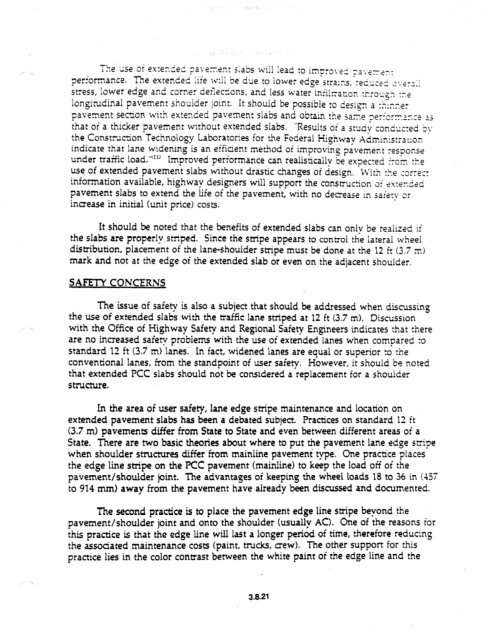chapter 3 rigid pavement - DOT On-Line Publications - Department ...
chapter 3 rigid pavement - DOT On-Line Publications - Department ...
chapter 3 rigid pavement - DOT On-Line Publications - Department ...
Create successful ePaper yourself
Turn your PDF publications into a flip-book with our unique Google optimized e-Paper software.
T?&e se Oi ?XieF.LeC TaL’e- . ..ent Gabs wiil !ead to imarot.ei ~a...e~,2~.I<br />
oer&mance. The extended Iiie wiil ‘be due to lower edge jtra:rs, :e~~;c~~ c’.‘iy’.; ‘.<br />
itress, lower edge and corner derlecsons, and less water inii!caton :h.:o:~k -A<<br />
longitudinal <strong>pavement</strong> shouider joint. It should be possible to design a :;&r~&<br />
<strong>pavement</strong> section with extended <strong>pavement</strong> slabs and obtain the 5am.e oerform.-arGce ~5<br />
that of a thicker <strong>pavement</strong> without extended slabs. “Results or’ a stud; conduczed 5..<br />
the Construction Technology Laboratories for the Federal Highway &hinist;acon ’<br />
indicate that lane widening is an effident method of improving Ravement ;es?or,s(r<br />
under traffic load.“‘“’ Improved performance can realistically be expected irorn the<br />
use, of extended <strong>pavement</strong> slabs without drastic changes of design. K’ith :he correct<br />
information available, highway designers will support the construction oi 2x:enCed<br />
<strong>pavement</strong> slabs to extend the life of the <strong>pavement</strong>, with no decrease in jar’s:); cr<br />
inaease in initial (unit price) costs.<br />
It should be noted that the benefits of extended slabs can oniv be realized ii<br />
the siabs are properly.striped. Since the stripe appears to control tie lateral wheel<br />
distribution, placement of the lane-shouider stripe must be done at the 12 ft (3.7 T-J<br />
mark and not at the edge of the extended slab or even on the adjacent shoulder.<br />
SAFETY CONCERNS<br />
The .issua of safety is also a subject that should be addressed when discussing<br />
the use of extended slabs with the traffic lane striped at 12 ft (3.7 m). Discussion<br />
with the Office of Highway Safety and Regional Safety Engineers indicates that there<br />
are no increased safety problems with the use of extended lanes when compared to<br />
standard 12 ft (3.7 m) lanes: In fact, widened lanes are equal or superior to rhe<br />
conventional ianes, from the standpoint of user safety. However, it should be noted<br />
that extended KC slabs should not be considered a replacement for a shoulder<br />
structure.<br />
In the area of user safety, lane edge stripe maintenance and location on<br />
extended <strong>pavement</strong> slabs has been a debated subject. Practices on standard I2 it<br />
(3.7 m) <strong>pavement</strong>s differ from Stqe to State and even between different areas of a<br />
State. There are two basic theories about where to put the <strong>pavement</strong> lane edge snipe<br />
when shoulder structures differ from mainline <strong>pavement</strong>’ type. <strong>On</strong>e practice places<br />
the edge line stripe on the PCC <strong>pavement</strong> (mainline) to keep the load off of the<br />
<strong>pavement</strong>/shoulder joint. The advantages of keeping the wheel loads 18 to 36 in (457<br />
to 914 mm) away from the <strong>pavement</strong> have already been discussed and documented:<br />
The second practice is to place the <strong>pavement</strong> edge line stripe beyond the<br />
<strong>pavement</strong>/shoulder joint and onto the shoulder (usually AC). <strong>On</strong>e of the reasons tor<br />
this practice is that the edge line will last a longer period of time, therefore reducing<br />
the associated maintenance costs (paint, trucks, crew). The other support for this<br />
practice lies in the color contrast between the white paint of the edge line and the<br />
3.8.21
















